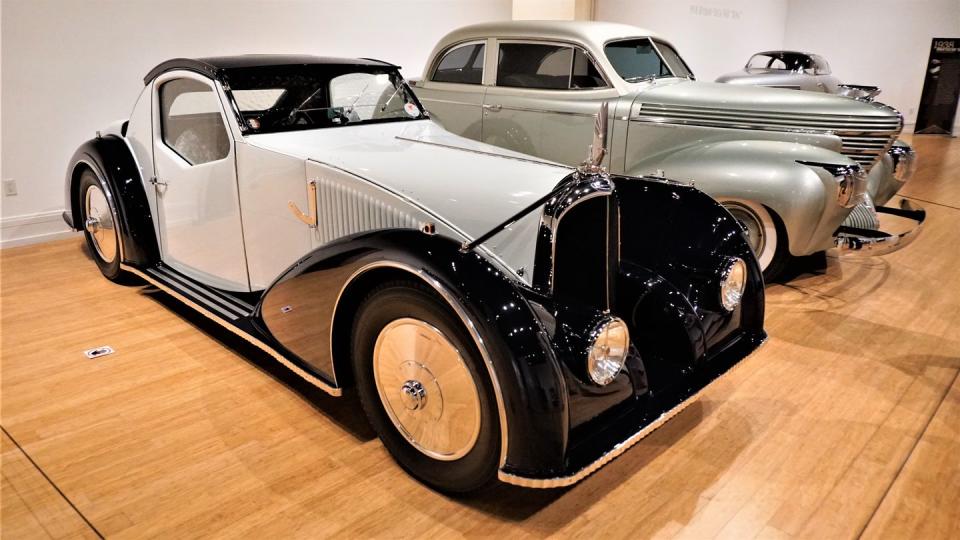How They Built Cars When Beauty Was All That Mattered

There was a time when it didn’t matter if your crossover utility vehicle had a third-row seat, and there was no government standard saying the front end had to be able to whack a pedestrian in just such a way, or that a frontal collision at an angle of 14.5 degrees had to result in deformation of no fewer than… Okay, you get the idea. For a small handful of cars designed in the 1930s, all that mattered was beauty. And aerodynamics. The two often worked in concert.
A new exhibit running through April 30 at Florida’s Vero Beach Museum of Art celebrates “Rolling Sculpture: Streamlined Art Deco Automobiles and Motorcycles.” The exhibit was five years in the making but was worth it.
“We started five years ago and then COVID kind of got in the way,” said guest curator Ken Gross.
Gross had already done a somewhat similar show in 2018 at the North Carolina Museum of Art and at the Portland Museum of Art called “The Shape of Speed: Streamlined Automobiles and Motorcycles 1930-42.” Gross spoke with the Vero Museum’s director Brady Roberts, who had spoken with Portland Art Museum director Brian Ferriso, and things got going.

It is surely one of the most beautiful collections of beautiful cars ever assembled. What makes these cars so gorgeous?
“Well, it’s a combination of art deco features and streamlining,” said Gross. “But in that era they didn’t know much about the science of streamlining.”
There were no CAD computers at the time, remember.
“If you look at the Tatra (1938 Tatra T77A), engineered by Hans Ledwinka, a contemporary of Ferdinand Porsche, (designer) Paul Jaray was experimenting and that car actually had some wind tunnel development.”
Others benefited from aircraft design of the era.
“Bill Stout (1936 Stout Scarab) designed airplanes, the first all-metal airplanes, so he had a sense of of streamlining as well. And (Giuseppe) Figoni felt that the teardrop was the most efficient streamline shape and you look at Figoni’s T 150 C, they literally call it that teardrop.”
Others are less easy to figure out.
“I don’t know what Russ Hines was thinking with the Phantom (Corsair) but that’s certainly like an airplane fuselage, as is the Hispano (-Suiza H6B Xenia) which was designed by Jean Andreau, a French aircraft designer and aerodynamicist. There’s a lot of aero in the sleekly rebodied Henderson motorcycle and the Chrysler Airflow, too, so streamlining with an Art Deco accent, that’s what we had in mind.”
Most of the cars are different from what was shown in Portland five years ago, made available by the generous donations of private collections and museums.
“They came from all over the country,” said Gross.
A couple of them took a lot of persistence to get.
“The Petersen Automotive Museum loaned the Round-Door Rolls, and the Rolls and the Phantom Corsair are an example of museums, saying, ‘We don’t loan those cars for any length of time. They’re the reason people come to our museum.’ I tried to be my most persuasive with (Petersen Museum Director) Terry Karges, but with the Phantom Corsair and the National Automotive Museum (in Reno), Jackie Frady, who was a friend of mine, was the director and for several years, and other exhibits, I tried to get that car, but Jackie kept saying same thing, ‘It’s the star car’ and so forth. So she retired and Phil McDougall became the director. So I said, ‘I’d like to come to Reno and talk to you.’ So I literally flew to Reno and took him to lunch. And we had a nice conversation about the car and I said, ‘You know, not everyone knows you have this museum. And if you’ll loan this car, it’s going to get publicity. It’ll be in a catalog, and I’d like you to consider it.’ After a board of directors meeting, they agreed to loan it so they don’t ever loan it to another museums. So I feel complimented that they did.”
It was worth all the hard work.

“That Hispano is a breathtaking car, and even a car like the Bendix is very attractive. Most people say, ‘What’s the Bendix (1934 Bendix SWC Sedan)?’ It’s from Victor Bendix, the brake manufacturer. They only built one. Bendix built it to show some new technology, like brakes that could be adjusted from the outside. It was built at the same time and designed at the same time as the Chrysler Airflow that it’s sitting next to, but in different parts of Detroit. The two parties did not know one another, didn’t know what they were doing until the two cars came out. But Bendix was persuaded by his clients not to try to sell a car that competed with them. So only one of those was built. It was warehoused for something like half a century, and then it was pulled out and the Studebaker Museum has freshened it. It’s still on its original tires. But I like showing it with the Airflow because they have kind of a parallel development.”
The exhibit runs through April 30. You were planning to get out of that miserable winter weather up north and going to Florida anyway, weren’t you? Might as well aim for Central Florida, maybe include a stop at Disney World, and give it a visit.

 Yahoo Autos
Yahoo Autos 